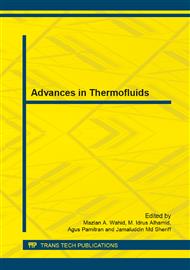[1]
M. Kauffeld, M. Kawaji, P.W. Egolf, Handbook on Ice Slurries Fundamentals and Engineering. IIF/IIR, Paris, (2005).
Google Scholar
[2]
A.S. Pamitran, H.D. Ardiansyah, M. Novviali, Unjuk Kerja Scraper Blade Evaporator dan Orbital Rod Evaporator pada Ice slurry Generator Berbahan Dasar Air Laut, SNTTM XII, Yogyakarta, (2012).
Google Scholar
[3]
P. Kirby, P.E. Nelson, Ice Slurry Generator, IDEA Conference, Texas, June, (1998).
Google Scholar
[4]
K. Kasza, U. Choi, J. Kaminsky, Advanced Energy Transmission Fluids for Heating and Cooling Systems, ASHRAE Trans. 93 (Pt. 2) (1988).
Google Scholar
[5]
M.J. Wang, V. Goldstein, Ice Slurry: Advanced Fish Chilling and Preservation Technology. Am. Fis Soc. Symp. 38 (2003) 379-386.
Google Scholar
[6]
C. Pineiro, J. Barros-Velazquez, S.P. Auboug, Effects of Newer Slurry Ice Systems on the Quality of Aquatic Food Product. Trends Food Sci. Technol. 15 (2004) 575-582.
DOI: 10.1016/j.tifs.2004.09.005
Google Scholar
[7]
R.P. Gupta, C.A. Fraser, 1990. Effect of New Friction Reducing Additive on Sunwell Ice Slurry Characteristics, National Research Council of Canada, Institute of Mechanical Engineering, Low Temperature Laboratory, Report no. TR-LT-023, NRC no. 32123, (1990).
Google Scholar
[8]
M. Kauffeld, K.G. Christensen, S. Lund, T.M. Hansen, Experience with Ice Slurry, Proceedings of the FirstWorkshop on Ice Slurries, Yverdon-les-Bains, Switzerland (1999) 42-73.
Google Scholar
[9]
B.D. Knodel, D.M. France, U.S. Choi, M.W. Wambsganss, Heat Transfer and Pressure Drop in Ice-Water Slurries. Applied Thermal Eng. 20 (2000) 671-685.
DOI: 10.1016/s1359-4311(99)00046-0
Google Scholar
[10]
J. Bellas, I. Chaer, S.A. Tassou, Heat Transfer and Pressure Drop of Ice Slurries in Plate Heat Exchangers. Applied Thermal Eng. 22 (2002) 721-732.
DOI: 10.1016/s1359-4311(01)00126-0
Google Scholar
[11]
E. Stamatiou, M. Kawaji, Thermal and Flow Behavior of Ice Slurries in a Vertical Rectangular Channel. Part II. Forced Convective Melting Heat Transfer. Int. J. Heat Mass Transfer 48 (2005) 3544-3559.
DOI: 10.1016/j.ijheatmasstransfer.2005.03.019
Google Scholar
[12]
D.W. Lee, E.S. Yoon, M.C. Joo, A. Sharma, Heat Transfer Characteristics of the Ice Slurry at Melting Process in a Tube Flow. Int. J. Refrigeration 29 (2006) 451-455.
DOI: 10.1016/j.ijrefrig.2005.10.003
Google Scholar
[13]
B. Niezgoda-Zelasko, W. Zalewski, Momentum Transfer of Ice Slurry Flows in Tubes, Experimental Investigations. Int. J. Refrigeration 29 (2006a) 418-428.
DOI: 10.1016/j.ijrefrig.2005.09.007
Google Scholar
[14]
B. Niezgoda-Zelasko, W. Zalewski, Momentum Transfer of Ice Slurry Flows in Tubes, Modelling. Int. J. Refrigeration 29 (2006b) 429-436.
DOI: 10.1016/j.ijrefrig.2005.09.006
Google Scholar
[15]
J.P. Be´de´carrats, F. Strub, C. Peuvrel, Thermal and Hydrodynamic Considerations of Ice Slurry in Heat Exchangers, International Journal of Refrigeration 32 (2009) 1791-1800.
DOI: 10.1016/j.ijrefrig.2009.04.002
Google Scholar
[16]
P.W. Egolf, M. Kauffeld, From Physical Properties of Ice Slurries to Industrial Ice Slurry Applications, International Journal of Refrigeration 33 (2010) 1491-1505.
DOI: 10.1016/j.ijrefrig.2004.07.014
Google Scholar
[17]
J.W. Mullin, Crystallization (4th ed. ). London: Butterworths, (2001).
Google Scholar
[18]
Leon, M. Miguel, R.G. Rocion, M.G. Juan J., Braga, L. Sergio, Ice Slurry Generation Based on Sugar Ethanol Aqueous Solution, International Refrigeration and Air Conditioning. (2006).
Google Scholar
[19]
E. Stamatioua, J.W. Meewisseb, M. Kawajia, Ice Slurry Generation Involving Moving Parts, International Journal of Refrigeration 28 (2005) 60-72.
DOI: 10.1016/j.ijrefrig.2004.07.016
Google Scholar
[20]
T. Asaoka, A. Saito, S. Okawa, H. Kumano, T. Hozumi, T. Matsunaga, J. Ichioka, Study on Formation of Ice Slurry using Ethanol Solution with Vacuum Evaporation, Trans JSRAE 23(2) (2206) 165-74.
DOI: 10.1016/j.ijrefrig.2008.09.004
Google Scholar
[21]
H. Hasegawa, N. Yoshi, M. Saikawa, Study on Dynamic Contact Ice Making Characteristics of Water as Refrigerant, Proc. JSRAE Annual Conf, C108, (2002).
Google Scholar
[22]
T.A. Mouneer, M.S. El-Morsi, M.A. Nosier, N.A. Mahmoud, Heat Transfer Performance of a Newly Developed Ice Slurry Generator: A Comparative Study. Ain Shams Engineering Journal (2010) 1, 147-157.
DOI: 10.1016/j.asej.2011.05.004
Google Scholar
[23]
N.E. Wijeysundera, M.N.A. Hawlader, C.W.B. Andy, M.K. Hossain, Ice-slurry Production using Direct Contact Heat Transfer, International Journal of Refrigeration 27 (2004) 511-519.
DOI: 10.1016/j.ijrefrig.2004.03.007
Google Scholar
[24]
M.J. Wang, T.M. Hansen, M. Kauffeld, K.G. Christensen, V. Goldstein, Application of Ice Slurry Technology in Fishery, Proceedings of the 20th International Congress of Refrigeration, IIF/IIR, Vol. IV, 1999 paper 569.
Google Scholar
[25]
T. Vajda, Cryo-bioorganic Chemistry: Molecular Interaction at Low Temperature, Cellular & Molecular Life Sciences 56 (5-6) (1999) 398-414.
DOI: 10.1007/s000180050441
Google Scholar
[26]
J. Paul, Innovative Applications of Pumpable Ice Slurry, Institute of Refrigeration, London, UK, (2002).
Google Scholar
[27]
R. Dahuri, Prospek Pembangunan Perikanan Indonesia, Seminar Nasional Perikanan, IPB, Bogor, 46p, (2002).
Google Scholar
[28]
Kementrian Kelautan dan Perikanan, Badan Pusat Statistik, Jumlah Kapal/Perahu Berdasarkan Daerah Tangkapan, (2008).
Google Scholar
[29]
Yonvitner, Produktivitas Nelayan, Kapal dan Alat Tangkap di Wilayah Pengelolaan Perikanan Indonesia. Journal Fish Sci. IX(2) (2007) 254-266.
Google Scholar
[30]
K. S. Hilderbrand Jr., Preparation of Salt Brines for the Fishing Industry, Seafood Processing Specialist with Oregon State University, (1999).
Google Scholar
[31]
R. Feistel, D.G. Wright, K. Miyagawa, J. Hruby, D.R. Jackett, T.J. McDougall, W. Wagner, Development of Thermodynamic Potentials for Fluid Water, Ice and Seawater: A New Standard for Oceanography, Ocean Science Discussions, (2008).
DOI: 10.5194/osd-5-375-2008
Google Scholar
[32]
A. Melinder, Properties and Other Aspects of Aqueous Solutions Used for Single Phase and Ice Slurry Applications, International Journal of Refrigeration, 33 (2010 ) 1506-1512.
DOI: 10.1016/j.ijrefrig.2010.07.014
Google Scholar
[33]
C. Hägg, Ice Slurry as Secondary Fluid in Refrigeration Systems, Fundamentals and Applications in Supermarkets, School of Industrial Engineering and Management, KTH, (2005).
Google Scholar
[34]
A. Melinder, E. Granryd, Using Property Values of Aqueous Solutions and Ice to Estimate Ice Concentrations and Enthalpies of Ice Slurries, International Journal of Refrigeration, 28 (2005) 13-19.
DOI: 10.1016/j.ijrefrig.2004.07.013
Google Scholar
[35]
D.G. Thomas, Transport Characteristics of Suspension, A note on the Viscosity of Newtonian Suspensions of Uniform Spherical Particles, Journal of Colloid Science 20 (1965) 267–277.
DOI: 10.1016/0095-8522(65)90016-4
Google Scholar
[36]
J. Guilpart, E. Stamatiou, A. Delahaye, L. Fournaison, Comparison of the Performance of Different Ice Slurry Types Depending on the Application Temperature, International Journal of Refrigeration 29 (2006) 781-788.
DOI: 10.1016/j.ijrefrig.2005.11.009
Google Scholar
[37]
K. Kasza, K. Hayashi, Ice Slurry Cooling Research: Effects of Microscale Ice Particle Characteristics and Freezing Point-Depressant Additives on Ice Slurry Fluidity, ASHRAE Trans. 107 (Pt. 1) (2001a) 346-351.
Google Scholar


